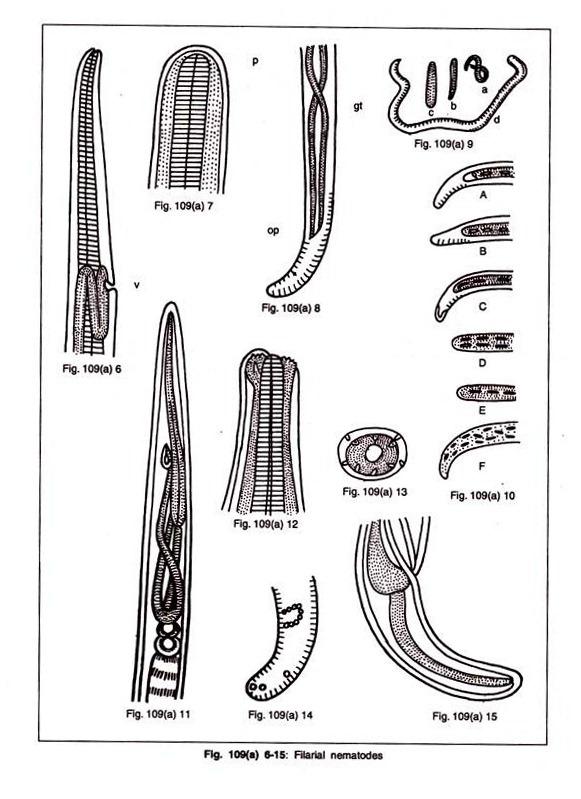The below mentioned article provides a short note on Wuchereria Bancrofti (Bancroftian Filariasis).
Morphology of Wuchereria Bancrofti (Bancroftian Filariasis):
The adult worm-male-20-40 x 0.1 mm [Fig. 109(a)]; female-80-100 x 0.2-0.3 mm [Fig. 109(a).2] is a long, minute, thread like and creamy white nematode. Posterior end of male [Fig. 109(a).4,5], anterior [Fig. 109(a).6, 7] and posterior end of female adult [Fig. 109(a).8].
Microfilariae:
Difference between mf. W. bancrofti [Fig. 109(a). 17] and Brugia malayi [Table 109(a)],
Life Cycle of Wuchereria Bancrofti (Bancroftian Filariasis):
When the infected female culex fatigans ingests sheathed microfilariae which later cast off sheath and penetrate into intestinal wall, transform in the thoracic muscle into 1st, 2nd and 3rd stage (infective) larva [Fig. 109(a). 9a, b, c, d] and enter mosquito proboscis; the infected larvae [Fig. 109(a) g, d] deposited on punctured skin, migrate settle, grow, sexually mature in lymphatic’s and fertilised, gravid female discharges, microfilariae into the peripheral blood.
Clinical Features:
It causes filarial granuloma in soft palate in Kerala, lymphangitis lymphadenitis, elephantiasis, hydrocele, chyluria, in India, the first case of inflammation of retinal epithelium and retinal vasculitis caused by microfilaria of W. bancrofti is reported.
Laboratory Diagnosis of Wuchereria Bancrofti (Bancroftian Filariasis):
(a) Microfilariae are demonstrated in Leishman or Acridine orange stained peripheral blood smear. Video microscopy can be used for B. malayi, calcified worms can be detected by X-ray.
(b) Serology:
IF AT, IHA and BF can also be used; but Dot-ELISA is recent sensitive method. New diagnostic skin test gives results within 15 minutes at day or night.
Treatment:
Diethylcarbamazine (DEC) mediated salt is strongly indicated as a safe, suitable inexpensive, efficient and practical method of control. Ivermectin (recent antihelminthic agent), single dose of 25-200 mg/kg. body weight is very effective. The excretory secretory antigens of B. malayi are effective in inducing resistance against filarial parasites, biological control of mosquito in India is by using Bacillus sphaerium.
